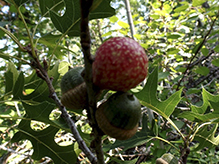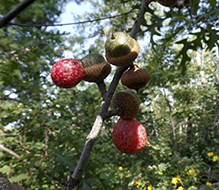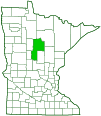acorn plum gall wasp
(Amphibolips quercusjuglans)
Conservation • Description • Habitat • Ecology • Distribution • Taxonomy
|
|
||||||||||||||
Description |
Acorn plum gall wasp insect is very small for a wasp but very large for a gall wasp. The female is ¼″ in length. The head is large and black, and has a finely wrinkled texture. The antennae are short, stout, and 12-jointed. The thorax is highly convex and very robust, wider than the head. It is black and has a coarsely wrinkled texture. It is marked with fine longitudinal lines that have the appearance of needle scratches. The lines in front (anterior) are fine and slightly spread apart. The lines near the wing bases are rather long. The plate between the wing bases (scutellum) is cushion-shaped, slightly wider than long, and has a wrinkled texture. The abdomen is black, and more or less opaque. The upper side is densely covered with tiny pits (punctate). The lower side is shiny, hairy, and not punctate. The legs are yellowish-brown. The wings are transparent and dusky, with a brownish area in the middle from the base to the tip. The male has 15-jointed antennae but is otherwise similar to the female. Like other cypnid wasps, this species is usually identified by the galls it produces. The galls are formed on the acorn cups of northern red oak in the spring or early summer. When they first appear the galls are small, pink, round, smooth, solid, and fleshy. As the larva grows the gall expands to ⅝″ to 1″ in diameter and turns blood red. Old galls are brown, dry, and so hard that they are difficult to cut with a knife. They easily drop off and are often found on the ground. It was once thought that the gall was caused by a chemical irritant that the female deposits with the egg. It was later learned that gall formation does not commence until the egg hatches or just before it hatches. It is now thought that the gall is a result of the irritating action of the larvae acting on developing plant cells. |
Size |
Total Length, Female: ¼″ |
Similar Species |
Spongy oak apple gall wasp (Amphibolips confluenta) galls are on leaves. They sometimes take over the entire leaf and appear to be on the twig. |
Habitat |
|
Ecology |
Season |
Winged adults active in the fall |
Behavior |
|
Life Cycle |
The life cycle of this wasp involves alternation of generations, one generation with only asexual females and one generation with both sexual males and sexual females. After mating in the fall the sexual female wasp drops to the ground. She burrows into the soil at the base of a host tree and injects her eggs into the tree’s roots. These eggs, the first generation embryo stage, overwinter. When they hatch in the early spring, the larvae begin feeding on the roots. Soon they enter the pupal stage, a period of inactivity and metamorphosis. Later, still in the spring, the wingless, asexual female adult hatches and emerges from the soil. She crawls up the tree trunk, finds a developing acorn, and injects a single egg into the cup. She then finds another acorn and repeats the process with her remaining eggs. These eggs are the second generation embryo stage. The egg hatches and the larva begins feeding on the acorn cup. This causes a chemical reaction that results in the formation of a ball-like gall. The galls appear in the late spring or early summer. As the season progresses the larva gets larger and so does the gall. Second-generation, winged, male and female sexual adults emerge in the fall and immediately search out a mate. The cycle continues. |
Larva Hosts |
In Minnesota, only northern red oak (Quercus rubra) |
Adult Food |
Adult wasps do not feed. |
Distribution |
||
|
Sources |
|
| 6/14/2025 | ||
Occurrence |
||
|
||
Taxonomy |
|
Order |
Hymenoptera (Ants, Bees, Wasps, and Sawflies) |
Suborder |
Apocrita (narrow-waisted wasps, ants, and bees) |
Infraorder |
Proctotrupomorpha |
Superfamily |
Cynipoidea (gall wasps and allies) |
Family |
Cynipidae (gall wasps) |
Subfamily |
Cynipinae |
Tribe |
Cynipini (oak gall wasps) |
Genus |
Amphibolips |
Subordinate Taxa |
|
|
|
Synonyms |
|
Amphibolips prunus Cynips quercusjuglans Cynips quercusprunus |
|
Common Names |
|
acorn plum gall wasp |
|
Glossary
Gall
An abnormal growth on a plant produced in response to an insect larva, mite, bacteria, or fungus.
Punctate
Dotted with pits (punctures), translucent sunken glands, or colored spots of pigment.
Scutellum
The exoskeletal plate covering the rearward (posterior) part of the middle segment of the thorax in some insects. In Coleoptera, Hemiptera, and Homoptera, the dorsal, often triangular plate behind the pronotum and between the bases of the front wings. In Diptera, the exoskeletal plate between the abdomen and the thorax.
Visitor Photos |
||
Share your photo of this insect. |
||
This button not working for you? |
||
|
||
MinnesotaSeasons.com Photos |
||
Luciearl |
||
Acorn Plum Gall Not sure if there is a category for these, but neat to find them still on the tree. I have only found the Acorn Plum Galls on the ground in the past. |
||
 |
 |
|
 |
||

Slideshows |
|

Visitor Videos |
||
Share your video of this insect. |
||
This button not working for you? |
||
|
Other Videos |
||
|

Visitor Sightings |
||
Report a sighting of this insect. |
||
This button not working for you? |
||
| Luciearl 8/11/2018 |
Location: Fairview Township Not sure if there is a category for these, but neat to find them still on the tree. I have only found the Acorn Plum Galls on the ground in the past. |
 |
MinnesotaSeasons.com Sightings |
||
|

Created: 8/18/2019 Last Updated: © MinnesotaSeasons.com. All rights reserved. |
